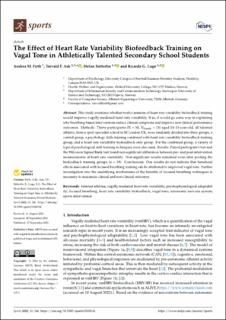| dc.contributor.author | Firth, Andrea M. | |
| dc.contributor.author | Ask, Torvald Fossåen | |
| dc.contributor.author | Sütterlin, Stefan | |
| dc.contributor.author | Lugo, Ricardo Gregorio | |
| dc.date.accessioned | 2023-01-20T13:00:36Z | |
| dc.date.available | 2023-01-20T13:00:36Z | |
| dc.date.created | 2022-09-21T14:10:19Z | |
| dc.date.issued | 2022 | |
| dc.identifier.citation | Sports. 2022, 10 (10), Artikkel 146. | en_US |
| dc.identifier.issn | 2075-4663 | |
| dc.identifier.uri | https://hdl.handle.net/11250/3044962 | |
| dc.description.abstract | This study examines whether twelve sessions of heart rate variability biofeedback training would improve vagally mediated heart rate variability. If so, it would go some way in explaining why breathing based interventions reduces clinical symptoms and improves non-clinical performance outcomes. Methods: Thirty participants (N = 30, Nfemale = 13) aged 14–13-year-old talented athletes from a sport specialist school in SE London UK, were randomly divided into three groups, a control group, a psychology skills training combined with heart rate variability biofeedback training group, and a heart rate variability biofeedback only group. For the combined group a variety of typical psychological skill training techniques were also used. Results: Paired participant t test and the Wilcoxon Signed Rank test found non-significant differences between pre- and post-intervention measurements of SDNN, HF Log, pNN50 and RMSSD Log heart rate variability. Non-significant results remained even after pooling the biofeedback training groups (n = 19). Conclusion: Our results do not indicate that beneficial effects associated with focused breathing training can be attributed to improved vagal tone. Further investigation into the underlying mechanisms of the benefits of focused breathing techniques is necessary to maximize clinical and non-clinical outcomes. | en_US |
| dc.language.iso | eng | en_US |
| dc.publisher | MDPI | en_US |
| dc.rights | Navngivelse 4.0 Internasjonal | * |
| dc.rights.uri | http://creativecommons.org/licenses/by/4.0/deed.no | * |
| dc.subject | talented athletes | en_US |
| dc.subject | vagally mediated heart rate variability | en_US |
| dc.subject | psychophysiological adaptability | en_US |
| dc.subject | focused breathing | en_US |
| dc.subject | heart rate variability biofeedback | en_US |
| dc.subject | vagal tone | en_US |
| dc.subject | autonomic nervous system | en_US |
| dc.subject | sports intervention | en_US |
| dc.title | The Effect of Heart Rate Variability Biofeedback Training on Vagal Tone in Athletically Talented Secondary School Students | en_US |
| dc.type | Peer reviewed | en_US |
| dc.type | Journal article | en_US |
| dc.description.version | publishedVersion | en_US |
| dc.rights.holder | © 2022 by the authors. | en_US |
| dc.subject.nsi | VDP::Medisinske Fag: 700::Idrettsmedisinske fag: 850 | en_US |
| dc.source.volume | 10 | en_US |
| dc.source.journal | Sports | en_US |
| dc.source.issue | 10 | en_US |
| dc.identifier.doi | https://doi.org/10.3390/sports10100146 | |
| dc.identifier.cristin | 2053968 | |
| dc.source.articlenumber | 146 | en_US |
| cristin.ispublished | true | |
| cristin.fulltext | original | |
| cristin.qualitycode | 1 | |

